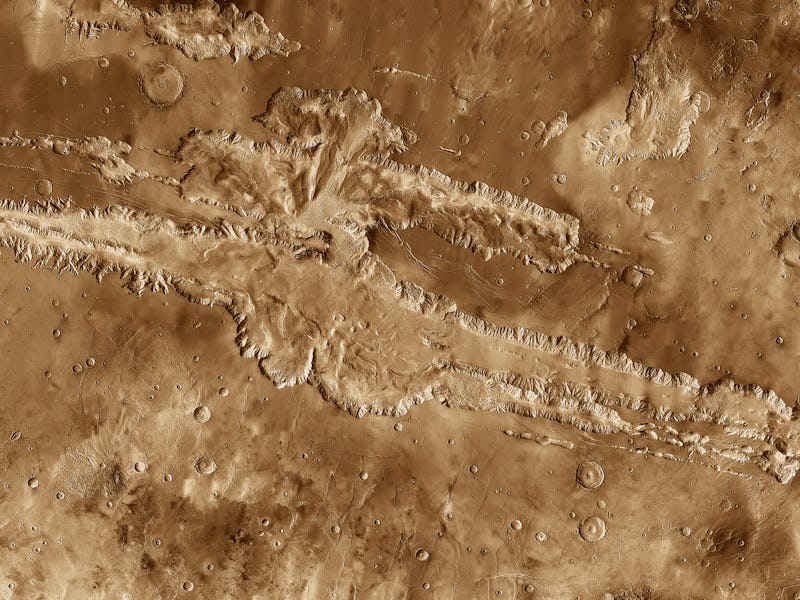A new study suggests Mars once hosted life — but the results reveal a worrying fate
This does not bode well.

On Earth, methane is one of our most potent and worrying greenhouse gasses, 84 times more damaging than carbon dioxide, and one of the oldest waste products of life on our planet. But a new simulation by a French team published in Nature Astronomy suggests that if methanogenic microbes evolved on another planet — Mars — they would have had a very different effect: causing out-of-control cooling instead of warming.
WHAT’S NEW — Based on older work modeling the early Earth’s biosphere, the team built a model of Noachian Mars — a period when the Red Planet was regularly bombarded by asteroids, had a thick atmosphere, and likely had liquid water on its surface.
Craters within the Hellas Basin reveal Mars’ rocky past.
The team knew that as the first life emerged on Earth, methanogenic bacteria that produced methane as waste helped warm and stabilize our planet’s climate. And scientists have long thought that methanogens, as some of the simplest and hardiest creatures known, might easily be able to thrive on Mars.
Because Noachian Mars showed “striking similarities in terms of surface conditions” to early Earth, study co-author and astrobiologist Boris Sauterey tells Inverse, the team expected they would be able to demonstrate that Martian methanogens likely had similar effects on its biosphere.
“We know that Mars was warm early on, so we would have provided the biological explanation for that early climate,” he says.
But they found the opposite. As the simulated Martian methanogens pumped more methane into the Red Planet’s atmosphere, the model planet teemed with subsurface life for a few hundred thousand years. But then, methane’s interactions with the Martian atmosphere and its briny ice caps cooled the planet to an extreme. The melting point of Martian ice plummeted past a point of no return. Within half a million years, Mars would become almost entirely smothered in a sheet of ice, the model predicted.
WHY IT MATTERS — As the model Martian glaciers advanced, only a handful of places on the team’s simulated Mars were left untouched: These were the planet’s lowest points, deep valleys, and craters where methanogens might have been able to survive.
NASA’s Perseverance rover has been investigating rocks at the front of the delta in Mars’ Jezero Crater along the path indicated in this annotated image taken by the agency’s Mars Reconnaissance Orbiter (MRO). The red star indicates the location of the rover in September 2022.
One of those places is Jezero Crater, which NASA’s Perseverance rover has been exploring since its arrival on Mars in 2021. Sauterey believes the new work will be useful for future Mars missions, too, as it could help identify ideal pockets of the surface where Mars’ primitive biosphere might have survived a possible ice age.
WHAT’S NEXT — Even though Sauterey and his team’s models suggest life would likely not survive in the long term on the Martian surface, the next step is to expand the simulation across epochs. Noachian Mars was very similar to early Earth, but as the two diverged, Sauterey speculates, “is it possible that Mars today is still habitable and potentially inhabited by organisms that would be descendants of that primitive biosphere.”
Jezero Crater floor, as imaged by Perseverance Rover.
If it is — and he emphasizes that’s a big if, since “just because a planet is habitable, it truly doesn’t mean that life appeared” — it would be below the surface and located at some of Mars’ lowest points: Jezero, Isidis Planitia, and Hellas Planitia. Jezero is a hotspot now, but Hellas has only been visited once, and that was by accident when the Soviet Union’s Mars 2 lander crashed there in 1971.
Beyond this, Sauterey points to the team’s model as a tool to help understand if planets in our Solar System and others might harbor life. Rather than early life being easily self-sustaining, biospheres could enter into feedback loops that lead to their own deterioration.
“We know right now we are making our planet less and less habitable… but the fact that a very primitive biosphere could have cooled down the climate of Mars severely, potentially rendering it uninhabitable, kind of points to the fact that potentially one of the limiting factors of the commonality of life in the universe is life itself,” Sauterey says.
On Earth, he adds, that has not been the case — at least not yet.
“Hopefully, on Earth, that tendency did not exist and was compensated by other things, but potentially it is a common fate of life in the universe to self-destruct.”